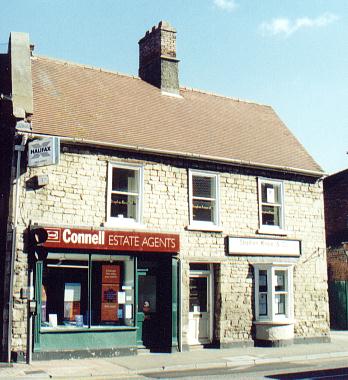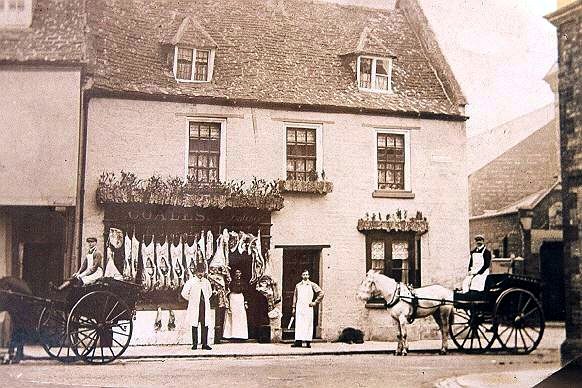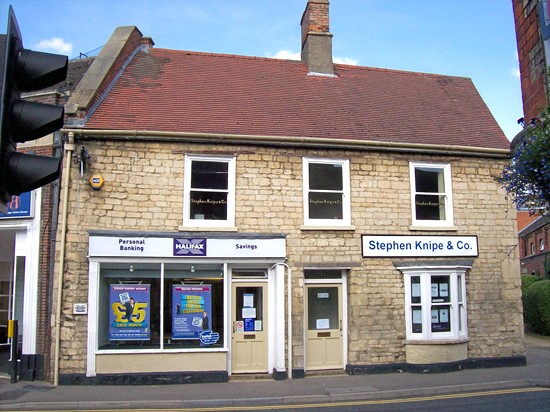|
The
Everlasting
Meat
A
STRANGE TALE FROM
THE
LEG OF MUTTON SHOP
|
 |
The meat that
never spoils has been
a myth of the retail butchery trade for several centuries and Bourne is one of those places that has helped perpetuate the legend. The most famous instance of the everlasting joint was a large rump roast that was hung in the fish and meat room of the Castle Market at Sheffield in 1836 where it remained for 140 years before being transferred to a glass case in 1976.
Bourne's claim does not have such longevity but the tale is no less curious. The meat was a leg of mutton that was hung by Mr Charles Featherstone in his butcher's shop at No 1 Abbey Road sometime around 1856. Mr George Gelsthorpe, a retired butcher, worked in the shop as a 13-year-old boy in 1910 and
over seventy years later, when 84 years old, he recalled the incident:
"This leg of mutton started off by hanging in the shop for sale and it was bought by a customer on the Monday and he said he would call back for it but he never did and it was left where it was in case he did. But instead of it going rotten, the meat mummified and if you tapped it, it would turn to powder." The customer is believed to have been in Bourne on a shopping trip but by evening, he had drunk so much that he forgot about his purchase.
The fact that the meat survived is surprising because Mr Gelsthorpe remembered that in those days, uncooked half carcasses were frequently hung outside the shop overhanging the pavement where butchers cut them up as they were sold. "I was often asked by the boss to go outside and pick the fly-blows off them", he said.
On 13th February 1886, the Grantham
Journal carried a news item about the meat under the heading "The
Venerable Leg of Mutton" although its date of origin was put at 1879
rather than 1856. "Many people like their mutton well hung but there is a
limit to all things", said the report. "Few people we opine would care to
have their meat hung more than a year. A correspondent tells us that a
venerable leg of mutton is to be seen in the shop of a noted butcher in
Bourne. Nearly seven years ago the leg was 'hung' by order of a customer
who however neglected to fetch it and it has remained on the hook ever
since. Time has, of course, had considerable effect upon it, lending it to
quite an antiquated appearance and it is now numbered among the 'rarities'
of the town.. If there is anything left but the bone it must indeed be
getting very high."
On 26th February 1906, the Yorkshire Post also carried an item about the mutton in their Chit-chat column that said: "Hanging to a rafter in a shop in Bourne is a leg of mutton fifty years old. It was bought from the present occupier's predecessor by a gentleman who said he would call for it later on but failed to do so. It has so withered that it resembles a shillelagh."
The story of the everlasting meat was popular in the neighbourhood and the butchery became known as the Leg of Mutton Shop. Children would frequently call in to have a look and customers were regaled with tales of its history while they waited to be served although on one occasion it was actually removed from display because a shopper complained that it looked revolting.
The meat was eventually preserved in a glass fronted case which hung on the wall and
remained in the shop when it was taken over by Aughton Brothers of
Stamford and then in 1922 by Mr William Elwes of W M Elwes and Sons, butchers.
He moved out in 1938 and left the joint behind and as the property was
unoccupied, it was requisitioned by the army during the Second World War
of 1939-45. The Lincolnshire Regiment were encamped in Bourne for a time
and soldiers who slept there have been blamed for destroying the
everlasting meat because it has never been seen since.
No
1 Abbey Road is still in use today but there is not a joint of meat in
sight. It is occupied by Connell, the estate agents, the Halifax Building
Society and Stephen Knipe and Co., the auctioneers and valuers.
|
 |
|
The butcher's shop
at 1 Abbey Road circa 1910 when it was kept by George Samuel
Coales who bought the business from Mr Featherstone although he
had previously had premises in West Street. George was a member of
a prominent family of Bourne tradesmen and his father Edward
Coales was a grocer, corn merchant and flour dealer in Church Lane
during the latter part of the 19th century. He is pictured
outside the shop with his wife Harriet posing for this trade
photograph with their butchery assistant Harry Bentham, holding
the knife, while the couple's adopted son George Gann is seated in
the delivery cart on the left and their other deliveryman in the
cart on the right. George Coales lived above the shop where he
died on 23rd December 1914 after a long illness although he
continued to supervise the business until the end. |
|
 |
WRITTEN JULY 2008
See also No 13 North Street

Go to:
Main Index Villages
Index
|


